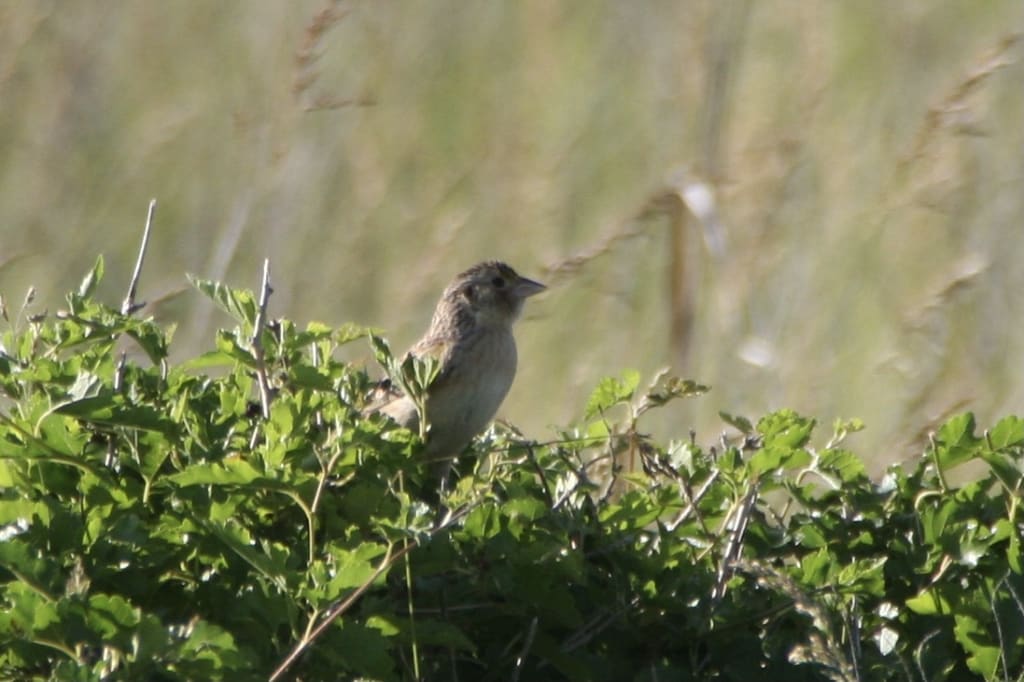Birding Year Round in NE Missouri — July - September
Spark Bird Vol. 2, Issue 1

July
It was in July a few years ago when we found a new birding location, within walking distance of our house. I even made an exciting discovery — a nest I have been keeping an eye on ever since.
After walking down the bluff that our house sits on, we have to walk a mile or so on the shoulder of Highway 61. I don’t like this part, but what comes after more than makes up for the inconvenience. Once off the highway, we head east towards the Mississippi, on or along a levee between two farm fields. Corn or soybean is planted here, unless the river floods the area, which happened often until last year, when they “fixed” the north-south levee.
On this first day of visiting the area, I noticed a Belted Kingfisher sitting on a power line. It was watching a small pond, and pretty soon, we saw it catch and eat a fish. Near the pond, there were a few dead cottonwood trees, providing home to a noisy family of Red-headed Woodpeckers. On the other side of the levee, we spotted two Blue-winged Teal swimming under the leaning plants by the shore. We also saw an Eastern Phoebe, a Great-crested Flycatcher, and an Eastern Kingbird enjoying the slough, with the abundance of mosquitoes available.
Four Turkey Vultures were circling above the river, and a few more joined them shortly afterwards. They flew in a bowl shaped pattern, a kettle. I have seen hawks do this often, too: the warm air currents rising from the ground take the birds upwards in a spiral, then without ever flapping their wings, they can glide to the next current which takes them up again. I think this is an awesome way for these birds to cover huge distances. In the fall, I sometimes see hundreds of Turkey Vultures migrate south using the air currents this way.
Suddenly, a splash from the river caught my attention. A Bald Eagle was now taking a sharp, 180 degree turn, holding a fish, and flying south. I followed it with my eyes as it landed in a tree not far from the intersection of the two levees where we were standing. Where exactly did it go? Why did it take the fish to that tree? We decided to try and find the eagle, because I figured an adult bird around here in the summer could very well have a nest somewhere near.
The levee along the river was rough to walk. The Corps of Engineers rebuilt it after an especially bad flood in the spring — they used compacted soil from local farmlands, with heavy boulders lining it on the river side. The deep bulldozer tracks running on top were the only walkable areas, the rest was overgrown with shoulder-high vegetation, home to a lot of insects and some small birds. I was able to take a good look at Song Sparrows, Swamp Sparrows, a Lark Sparrow, a Savanna Sparrow, and a few Chipping Sparrows as we pressed through the thickets.
I was pretty sure the eagle had landed in the last of the cottonwoods lining the river. It was a big, handsome tree, with its leaves rustling in the wind. Standing beside it, I noticed the marks of an ambitious beaver near the base. A Red-bellied Woodpecker was stubbornly whacking at one of the lower limbs. On the higher branches, I saw a huge mound of sticks — an eagle nest. Four heads were showing, three brown ones and one white. We stayed and watched the family for a while. One of the youngsters made an attempt at climbing up to the side of the nest, but it was not strong enough to keep itself stable, and kept stumbling back into the nest, right on top of its siblings.
Back at the house, I tried to find the nest from the east-facing window with the binoculars. Sure enough, I could see the tree right across from our house. I keep an eye on the nest, and each summer there has been two or three fledglings.
August
No matter where I go in August in my northeast Missouri birding area, I am sure to see American Goldfinches, a few species of sparrows, and the usual woodpeckers, the same ones that come to my feeders in the winter. Blue Jays and cardinals are also here year round. I used to think that these were not very exciting birds, but I have come to realize that there are interesting things about all birds, I just need to pay attention. I also like to visit different locations and watch how the birds behave differently depending on their surroundings.
The summer days are often hot and muggy around here, so we try to time our longer hikes (and birding) for cooler days, early mornings, or evenings. One morning, we got up at dawn to beat the heat and visit Wakonda State Park to see what we can find there.
The first section of the Jasper Lake trail leads through a small patch of trees along the shore. The usual birds greeted us in the woods. As we reached a more open area, a Belted Kingfisher flew out from the tree leaning over the water. Around here, they can be found year round, but it is interesting to watch their numbers fluctuate as the individuals that migrate come through.
As we walked east in between a farm field and the lake, I heard an unfamiliar sound from the shrubs. I knew it was a small bird and that I should know its song, but I could not identify it. Once it popped out and I watched it fly away, I knew it was another Dickcissel. They always get me. I can’t seem to remember their song, even though they are everywhere. The process of elimination should help me, too — there aren’t too many species that thrive in such habitats as the edges of cornfields, yet quick identification seems beyond my abilities.
Since we stopped hiking anyway, I took out my binoculars. On the opposite shore, there was a Lesser Yellowlegs foraging in shallow water. I was hoping to see it from closer, but it disappeared by the time we made our way around the lake. Instead, I spotted a few Killdeer.
I wasn’t expecting to find anything new on the way back to the car, but Wakonda held another surprise for me. The south section of the trail leads through a narrow passageway between Lake Jasper and Lake Agate. Looking out to the bigger of the two lakes, I noticed a small brown bird resurfacing from a dive. It was a Pied-billed Grebe! I rarely see them here, because their main migration route is somewhat west of us. It is not likely to stay long, either — it will be heading southeast, along with the other travelers.
September
As exciting as it would be, I don’t expect to see many FOY, first-of-year, birds in September. It’s already the ninth month of the year. Migratory warblers are coming through again, but I have already recorded those in the spring, when it was easy to identify them — adult birds in their breeding plumage. Sometimes I think I see a new bird in the fall, only to figure out that it is really a hatch-year individual, belonging to the species I quickly identified in the spring.
Then there are the “empid” flycatchers. Multiple species of this genus are here during fall migration, so technically, I could find a FOY bird among them. However, the appearance of the adults is very similar, and the small difference in their breeding habitat preference doesn’t help. Their vocalization would be my only chance to be certain that I have found a new species, but, as I mentioned earlier, I’m not very good at birding by ear yet.
Of course, there are lots of other birds I have never seen, even though they live here or come through during migration. For example, if I could find a Yellow-breasted Chat, a bird that I know should live here, it would be a life bird and a FOY. It seems my best bet is to keep looking for new places in the area, ones that offer somehow different habitats from my usual birding spots.
A few years ago in the fall, I was able to persuade my Mom to take me to a conservation area not too far from us. She likes hiking, but at CAs, there are never any guarantees of trails to follow, and she is not a huge fan of bushwhacking. Luckily, Rose Pond turned out to be a healthy sand-prairie, an easy place to wander and discover plants and animals. (On later hikes, I was able to find five different species of turtles — Eastern spiny softshell turtle, Common snapping turtle, Common map turtle, Red-eared slider, and Painted turtle — and I’m sure there are more. The small ponds and canals, shallow remnants of what used to be a huge floodplain marsh running all along the Mississippi, are still good habitats for turtles.)
So on this one day, we were following the somewhat vague directions to the area. We turned right “on the next unnamed gravel road” when I saw a lone Great Blue Heron on top of some irrigation equipment used on the corn fields. A pair of Mallards were feeding on algae in one of the canals, and lots of Mourning Doves were enjoying the bounty of the recently harvested field.
Once we parked the car and continued on foot, I heard the high-pitched song of Grasshopper Sparrows (on photo above). I also saw some Swamp Sparrows and a few Song Sparrows. About a half a mile into our hike, I noticed a small group of birds flying out of a bushy area in the meadow. They were Bobolinks! Two adult males, followed by some immatures and females. Their main breeding range is somewhat northwest of us, and I was very excited to see them. Life birds, and as such, FOYs in September!
I’m glad they were able to find a remote oasis where their native habitat remains intact. Over the years, I was also able to find other life birds at Rose Pond, such as the Black-crowned Night-Heron and the Henslow’s Sparrow, and I’m excited to go whenever Mom is willing to take me back.
About This Story
This story is the third part of an essay written by Zita Robertson (13) in 2021 as one of her submissions for the American Birding Association’s Young Birder Mentoring program. Zita lives in northeast Missouri, and when she’s not birding there, she goes on field trips just across the border in Iowa with the Iowa Young Birders.
All earnings from reads, any tips or pledges to the Spark Bird series here on Vocal.media fully and directly support the work of the Iowa Young Birders, a not-for-profit organization that promotes engagement with our natural world and conservation issues by empowering young Iowans to study and enjoy birds and birding.
The Iowa Young Birders does not endorse any of my other stories or series published here, and they remain independent of the views expressed in those.
To connect with the Iowa Young Birders, find them on the web @ iowayoungbirders.org.






Comments
Nellie Poppins is not accepting comments at the moment
Want to show your support? Send them a one-off tip.